Name Hildegard Peplau | Role Nurse | |
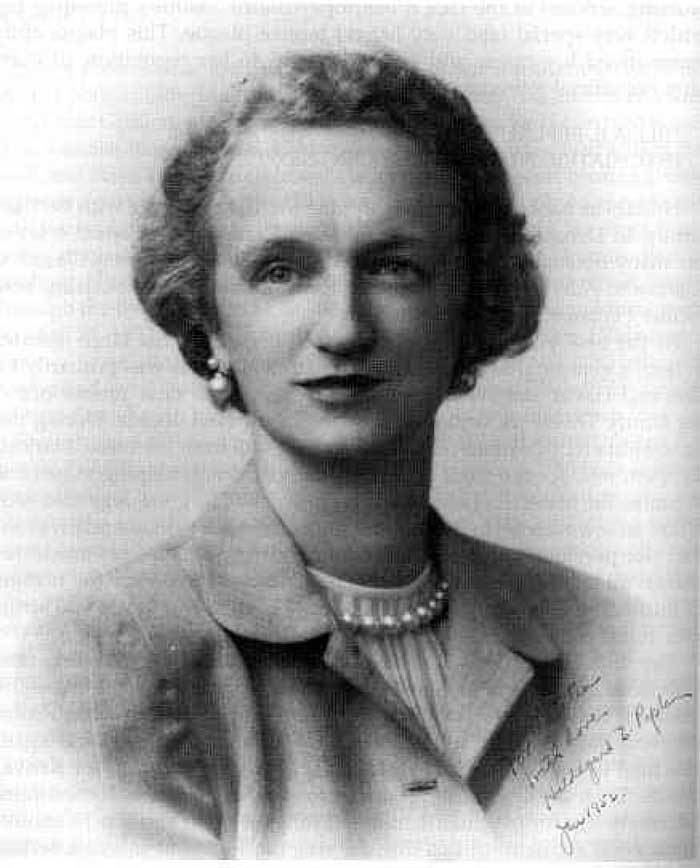 | ||
Died March 17, 1999, Sherman Oaks, Los Angeles, California, United States Books Interpersonal Relations in Nursing, Selected Works: Interpersonal Theory in Nursing Parents Gustav Peplau, Otyllie Peplau Education William Alanson White Institute (1954) Similar Virginia Henderson, Dorothea Orem, Callista Roy | ||
Life and legacy of hildegard peplau
Hildegard E. Peplau (September 1, 1909 – March 17, 1999) was an American nurse and the first published nursing theorist since Florence Nightingale and created the middle-range nursing theory of interpersonal relations, which helped to revolutionize the scholarly work of nurses. As a primary contributor to mental health law reform, she led the way towards humane treatment of patients with behavior and personality disorders.
Contents
- Life and legacy of hildegard peplau
- Hildegard Peplau Theory
- Early life
- Career
- Theoretical work
- Peplaus Six Nursing Roles
- Orientation Phase
- Identification Phase
- Exploitation Phase Working Phase
- Resolution PhaseTermination Phase
- References
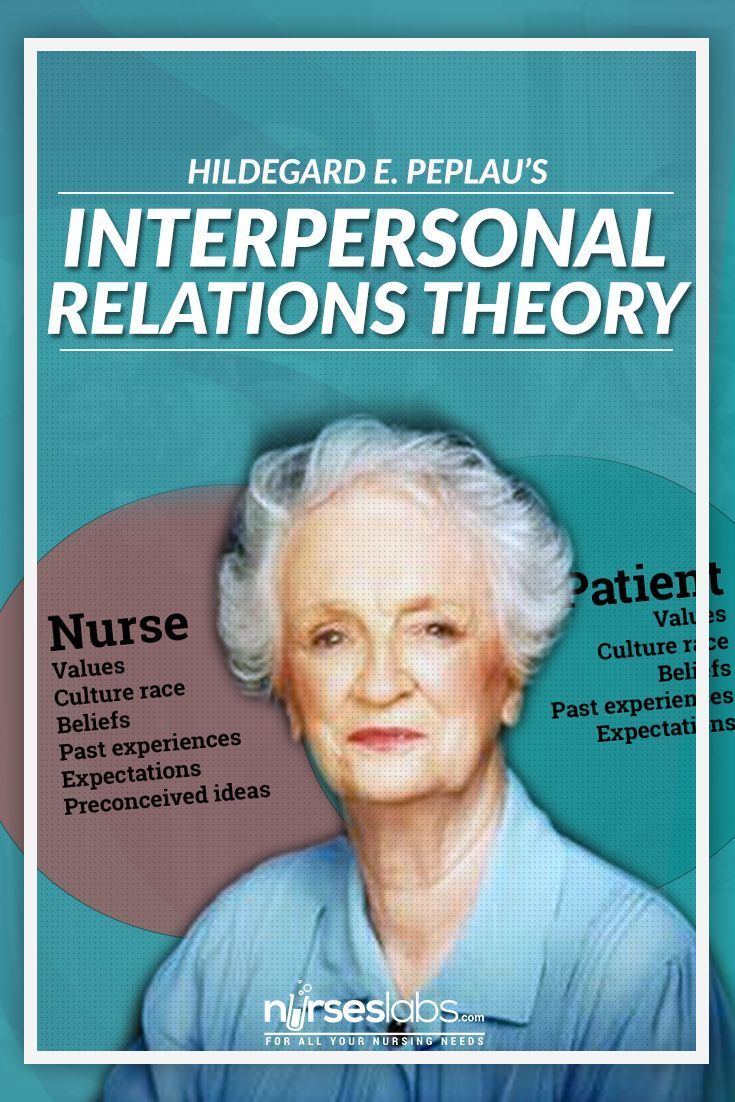
Hildegard Peplau Theory
Early life
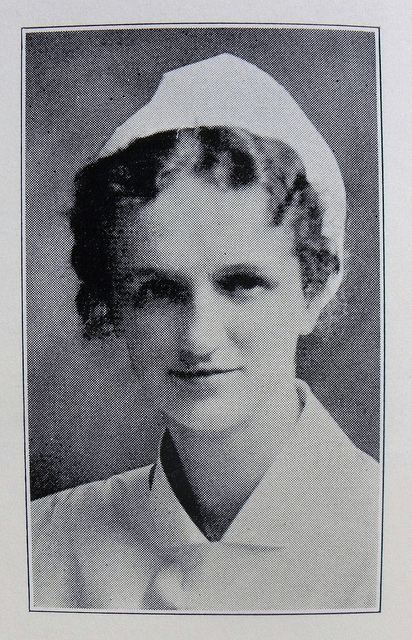
Hilda was born in Reading, Pennsylvania to immigrant parents of German descent, Gustav and Otyllie Peplau. She was the second daughter born of six children. Gustav was an illiterate, hard-working father and Otyllie was an oppressive, perfectionist mother. Though higher education was never discussed at home, Hilda was strong-willed, with motivation and vision to grow beyond traditional women’s roles. She wanted more out of life and knew nursing was one of few career choices for women in her day. As a child, she was watcher of people's behaviours. She witnessed the devastating flu epidemic of 1918, a personal experience that greatly influenced her understanding of the impact of illness and death on families. At this time she witnessed people jumping from windows in delirium because of the flu epidemic.

In the early 1900s, the autonomous, nursing-controlled, Nightingale era schools came to an end – schools became controlled by hospitals, and formal "book learning" was discouraged. Hospitals and physicians saw women in nursing as a source of free or inexpensive labor. Exploitation was not uncommon by nurse’s employers, physicians and educational providers. Nursing practice was controlled by medicine.
Career
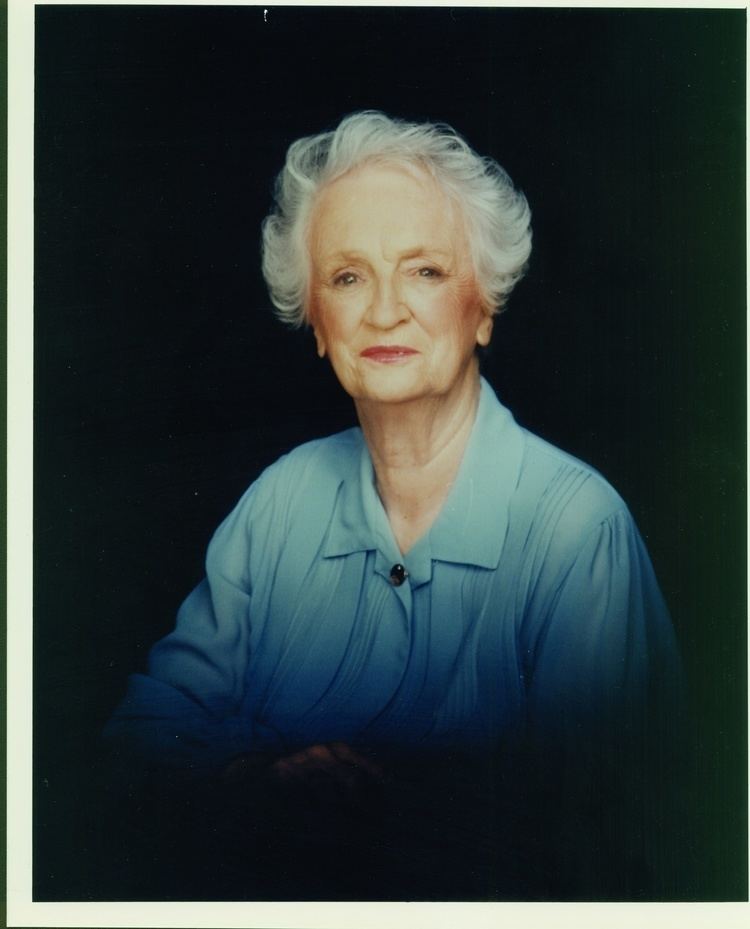
Peplau began her career in nursing in 1931 as a graduate of the Pottstown Hospital School of Nursing in Pottstown, PA. She then worked as a staff nurse in Pennsylvania and New York City. A summer position as nurse for the New York University summer camp led to a recommendation for Peplau to become the school nurse at Bennington College in Vermont. There she earned a bachelor's degree in interpersonal psychology in 1943. At Bennington and through field experiences at Chestnut Lodge, a private psychiatric facility, she studied psychological issues with Erich Fromm, Frieda Fromm-Reichmann, and Harry Stack Sullivan. Peplau’s lifelong work was largely focused on extending Sullivan’s interpersonal theory for use in nursing practice.

From 1943 to 1945 she served in the Army Nurse Corps and was assigned to the 312th Field Station Hospital in England, where the American School of Military Psychiatry was located. Here she met and worked with leading figures in British and American psychiatry. After the war, Peplau was at the table with many of these same men as they worked to reshape the mental health system in the United States through the passage of the National Mental Health Act o 1946.
Peplau held master’s and doctoral degrees from Teachers College, Columbia University. She was also certified in psychoanalysis at the William Alanson White Institute of New York City. In the early 1950s, Peplau developed and taught the first classes for graduate psychiatric nursing students at Teachers College. Dr. Peplau was a member of the faculty of the College of Nursing at Rutgers University from 1954 to 1974. At Rutgers, Peplau created the first graduate level program for the preparation of clinical specialists in psychiatric nursing.

She was a prolific writer and was equally well known for her presentations, speeches, and clinical training workshops. Peplau vigorously advocated that nurses should become further educated so they could provide truly therapeutic care to patients rather than the custodial care that was prevalent in the mental hospitals of that era. During the 1950s and 1960s, she conducted summer workshops for nurses throughout the United States, mostly in state psychiatric hospitals. In these seminars, she taught interpersonal concepts and interviewing techniques, as well as individual, family, and group therapy.
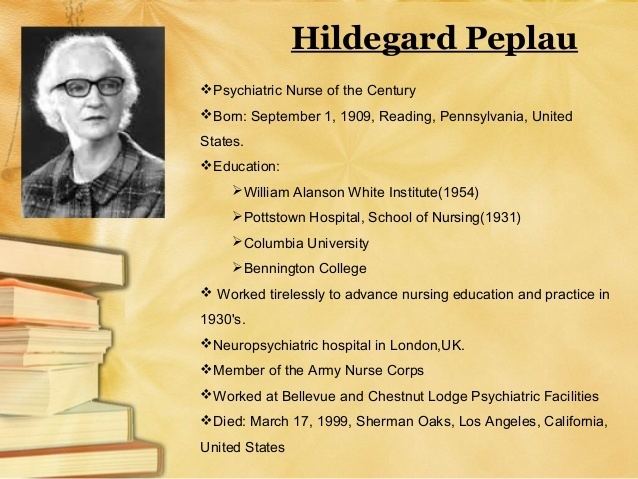
Peplau was an advisor to the World Health Organization and was a visiting professor at universities in Africa, Latin America, Belgium, and throughout the United States. A strong advocate for graduate education and research in nursing, she served as a consultant to the U.S. Surgeon General, the U.S. Air Force, and the National Institute of Mental Health. She participated in many government policy-making groups. She served as president of the American Nurses Association from 1970 to 1972 and a second vice president from 1972 to 1974. After her retirement from Rutgers, she served as a visiting professor at the University of Leuven in Belgium in 1975 and 1976.
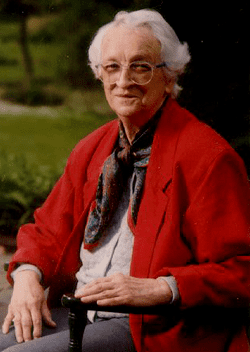
She died peacefully in her sleep at home in Sherman Oaks, California.
Theoretical work
In her interpersonal relationship theory, Dr. Peplau emphasized the nurse-client relationship as the foundation of nursing practice. Her book on her conceptual framework, Interpersonal Relations in Nursing, was completed in 1948. Publication took four additional years because it was groundbreaking for a nurse to contribute this scholarly work without a coauthoring physician.At the time, her research and emphasis on the give-and-take of nurse-client relationships was seen by many as revolutionary. Peplau went on to form an interpersonal model emphasizing the need for a partnership between nurse and client as opposed to the client passively receiving treatment (and the nurse passively acting out doctor's orders).The essence of Peplau's theories is the creation of a shared experience. Nurses, she thought, could facilitate this through observation, description, formulation, interpretation, validation, and intervention.For example, as the nurse listens to her client she develops a general impression of the client's situation. The nurse then validates her inferences by checking with the client for accuracy. The result may be experiential learning, improved coping strategies, and personal growth for both parties.
Peplau's Six Nursing Roles
Peplau describes the six nursing roles that lead into the different phases:
- Stranger role: Peplau states that when the nurse and patient first meet, they are considered to be strangers to one another. Therefore, the patient should be treated with much respect, courtesy and equally as anybody else. The nurse should not prejudge the patient or give assumptions on the patient but take the patient as they are. The nurse should treat the patient as emotionally stable, unless evidence states otherwise.
- Resource role: The nurse provides answers to questions primarily on health information. The resource person is also in charge of relaying information to the patient about the treatment and plan of care. Usually the questions are arisen from larger problems therefore, the nurse would determine what type of response is appropriate for constructive learning whether giving straightforward answers or providing information on counselling.
- Teaching role: The teaching role is a role that is a combination of all roles. Peplau determined that there are two categories that the teaching role consists of: Instructional and experimental. The instructional consists of giving a wide variety of information that is given to the patients and experimental is using the experience of the learner as a starting point to later form products of learning which the patient makes about their experiences.
- Counseling role: Peplau believes that counselling has the biggest emphasis in psychiatric nursing. The counselor role helps the patient understand and remember what is going on and what is happening to them in current life situations. Also, to provide guidance and encouragement to make changes.
- Surrogate role: The patient is responsible for putting the nurse in the surrogate role. The nurse’s behaviors and attitudes create a feeling tone for the patient that trigger feelings that were generated in a previous relationship. The nurse helps the patient recognize the similarities and differences between the nurse and the past relationship.
- Leadership role: Helps the patient assume maximum responsibility for meeting treatment goals in a mutually satisfying way. The nurse helps the patient meet these goals through cooperation and active participation with the nurse.
Orientation Phase
The orientation phase is initiated by the nurse. This is the phase during which the nurse and the patient become acquainted, and set the tone for their relationship, which will ultimately be patient centered. During this stage, it is important that a professional relationship is established, as opposed to a social relationship. This includes clarifying that the patient is the center of the relationship, and that all interactions are, and will be centered around helping the patient. This phase is usually progressed through during a highly impressionable phase in the nurse-client relationship, because the orientation phase occurs shortly after admission to a hospital, when the client is becoming accustomed to a new environment and new people. The nurse begins to know the patient as a unique individual, and the patient should sense that the nurse is genuinely interested in them. Trust begins to develop, and the client begins to understand their role, the nurse's role, and the parameters and boundaries of their relationship.
Identification Phase
The client begins to identify problems to be worked on within relationship. The goal of the nurse is to help the patient to recognize his/her own interdependent/participation role and promote responsibility for self.
Exploitation Phase / Working Phase
During the Working Phase, the nurse and the patient work to achieve the patient's full potential, and meet their goals for the relationship. A sign that the transition from the orientation phase to the working phase has been made, is if the patient can approach the nurse as a resource, instead of feeling a social obligation to the nurse (Peplau, 1997). The client fully trusts the nurse, and makes full use of the nurse's services and professional abilities. The nurse and the patient work towards discharge and termination goal.
Resolution Phase/Termination Phase
The termination phase of the nurse client relationship occurs after the current goals for the client have been met. The nurse and the client summarize and end their relationship. One of the key aspects of a nurse-client relationship, as opposed to a social relationship, is that it is temporary, and often of short duration (Peplau, 1997). In a more long term relationship, termination can commonly occur when a patient is discharged from a hospital setting, or a patient dies. In more short term relationships, such as a clinic visit, an emergency room visit, or a health bus vaccination visit, the termination occurs when the patient leaves, and the relationship is usually less complex. However, in most situations, the relationship should terminate once the client has established increased self-reliance to deal with their own problems.
